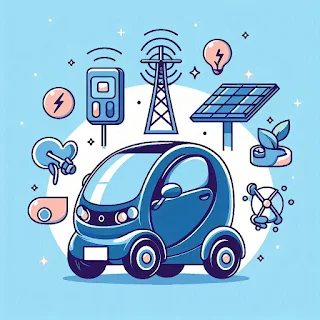Overview:
 |
| clip art of processor |
What is GaN?
Comparing compound semiconductor materials, gallium nitride (GaN) has better electrical characteristics than silicon. GaN is the best material option for high-frequency, high-power applications due to its wide bandgap, high electron mobility, and high breakdown voltage. Due to these characteristics, GaN devices can function at greater temperatures and voltages, which significantly boosts their performance and efficiency.Advantages of GaN Over Silicon:
1.Benefits of GaN Over Silicon:
Compared to silicon-based devices, GaN devices feature quicker switching speeds and lower on-resistance. Higher overall efficiency and a decrease in power losses are the outcomes, especially in power conversion and management systems.
2.Smaller Size:
Due to its higher efficiency and thermal conductivity, GaN can handle higher power densities. This allows for smaller, lighter, and more compact power electronics designs, which is crucial for portable and space-constrained applications.
3.Higher Operating Frequencies:
GaN can operate at much higher frequencies than silicon, making it ideal for RF and microwave applications. This higher frequency operation enables more efficient and compact power supplies and amplifiers.
4.Improved Thermal Performance:
GaN's superior thermal conductivity allows for better heat dissipation, reducing the need for bulky cooling systems and enhancing the reliability and lifespan of the devices.
Applications for GaN in Consumer Electronics:
Consumer Electronics:
GaN is making significant inroads into consumer electronics, particularly in chargers and power adapters. GaN-based chargers are smaller, lighter, and more efficient than their silicon counterparts, providing faster charging times and improved portability.
Electric Vehicles (EVs):
GaN technology for DC-DC converters, onboard chargers, and inverters is being quickly adopted by the automobile sector. Key barriers to the widespread use of electric cars are addressed by GaN's high efficiency and small size, which allow EVs go farther between charges and require less time to recharge.
Renewable Energy Systems:
GaN devices provide increased efficiency and reliability in solar inverters and wind power converters. This increases the conversion of energy and decreases heat loss, increasing the overall efficiency and sustainability of renewable energy systems.
Telecommunication:
5G networks and satellite communications depend on GaN's high-frequency capabilities. Higher power outputs and improved signal integrity are made possible by GaN amplifiers and transceivers, allowing quicker and more dependable communication networks.
Industrial Applications:
GaN is also transforming motor drives and power supplies for use in a variety of industrial automation and control systems, providing increased performance and efficiency.
Challenges and Future Outlook:
While GaN holds immense promise, there are still challenges to overcome. Manufacturing GaN devices can be more complex and costly than traditional silicon devices. However, as the technology matures and economies of scale are realized, the cost of GaN devices is expected to decrease.
The future of GaN in power electronics is bright. Continuous advancements in GaN technology are expected to further enhance its performance and reduce costs, making it more accessible for a wider range of applications. The ongoing research and development in this field promise to unlock new potentials and drive innovation in power electronics for years to come.
In summary:
Power electronics are being revolutionized by gallium nitride, which has several benefits over conventional silicon-based technology. Its increased efficiency, small size, and high-frequency capabilities are revolutionizing a variety of sectors, including consumer electronics, telecommunications, and renewable energy. GaN technology will surely have a significant impact on how power electronics develop in the future, spurring efficiency and innovation in a number of industries. Adopting GaN is a step towards a more efficient and sustainable future as well as a change in technology.










0 Comments